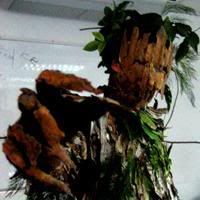Post by rajah on May 9, 2007 19:36:53 GMT 8
I have written my experience on germinating Nepenthes seed and would like to share it with you guys. Don't take this as the final truth as I am still learning, but at least you know how I do it.
I also have a pdf version of this article but I don't know how to include it here.
Nepenthes Seed Propagation
by Rajah (herbatrop@yahoo.com)
Germinating Nepenthes seeds is not difficult, provided that you have time, space and fresh seeds.
Nepenthes seed is thread-like, thickening in the middle like a spindle. In order to get seed, both a male and female Nepenthes must be in flower at the same time. Due to the thin shape of the seeds, each female flower can produce an abundance of seed. Considering some plants can have hundreds of female flowers, a large female Nepenthes can produce a large amount of seed. These seeds are contained in female pods that will turn brown when ripe. Once harvested, the seeds should be planted as soon as possible because Nepenthes seed can not be stored for long periods of time, and do not take well to the freezer. Some Nepenthes seeds such as N. ampullaria, N. gracilis and N. bicalcarata lose viability faster than the other.
The first key to germinating Nepenthes seeds successfully is choosing the right environment. It includes humidity, temperature and light. Nepenthes seeds need high humidity, warm temperatures and sufficient light in order to be able to germinate. Depends on the species (lowland/highland), most species will germinate in temperatures between 25 to 30 C. If you live in a non-equatorial country, bottom heat may be necessary.
I live in an equatorial climate of intermediate altitude around 650 m asl and I realize that not all of you who read this article have the same climate, so what I am going to share with you here is my experience on germinating Nepenthes seeds indoor. But even indoor I have relatively high humidity of around 60% and a constant room temperature of around 28 C.
You need a good medium that will hold as much water for as long as possible. Commonly there are three types of medium used to germinate Nepenthes seeds, dead sphagnum moss, coconut dust (cocopeat) and pure vermiculite. I use three of them interchangeably but I will focus on dead sphagnum moss here as it seems to be the most widely available medium.
Before usage, it is important to grind up the moss by using food processor or chopper until the fiber becomes somewhat finer. The reason for this is twofold: first, nepenthes seeds are so thin and light and they have to “see” the light to be able to germinate. Long-fiber moss has too much gap and holes between them that can make Nepenthes seeds disappear. Secondly, it can be very difficult to pluck Nepenthes seedlings out of long fiber, as the fiber in the moss can interconnect and disturb the other seedlings. You attempt to remove one seedling, and the moss fibers ends up disturbing or breaking the roots of several others. Long fiber itself should not be used unless the seedlings will grow on in their germination spot for a year or more.
you may rehydrate the moss with boiling water to sterilize it somewhat. If you cook it too much, the moss breaks down and molds very easily when it is eventually contaminated.
Here is how the ground up sphagnum moss looks like:
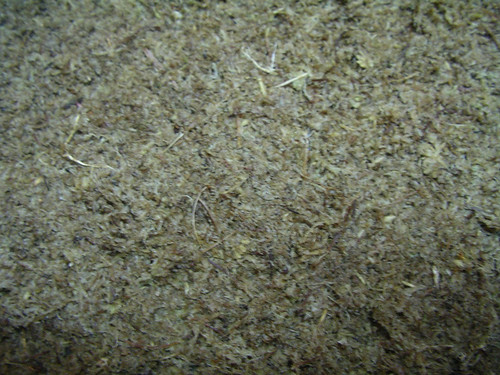
Next, get some plastic box, punch some holes on the bottom and fill the box with the chopped moss. Sphagnum moss is expensive, and there is no need to fill the box too deeply. About 1-2 cm thickness is sufficient because the roots of new seedlings are not that long, unless you plan to use individual pots from the very beginning. Water the moss until saturated and sow the seeds very sparingly. Wetting the soil one final time before planting the seed aids in getting the seed to sit in contact with the soil, which helps with germination. Do not cover the seeds because they have to see the light. It is best to spray the sown seed with a fungicide to keep the seeds from molding.
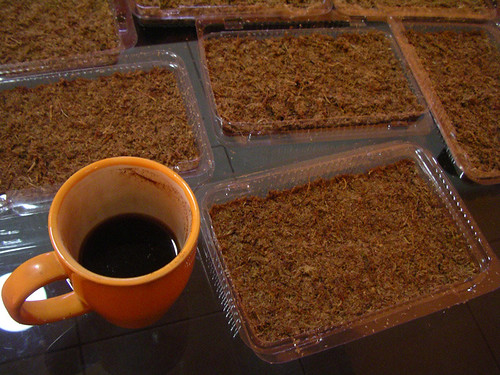
I choose 10 W daylight fluorescent light mainly because it is relatively cheap. I have found that this type of lamp works well, as long as you hang it close enough above the seeds, around 15-20 cm apart will be ideal. I turn the light on for 24 hours a day, but I have heard that 18 W fluoresent lights on 16 hours a day will do just well.
After setting up your lighting system, you need to have a humid environment for your seed box. There are many ways to accomplish this, but I like the water tray method. I use a discarded dish racks and modify it into a compact germinating room. Fill the rack with just enough water to maintain high humidity around the moss, close the box with a transparent lid with plenty of holes and put it on the rack. Keep the moss humid and the light on.
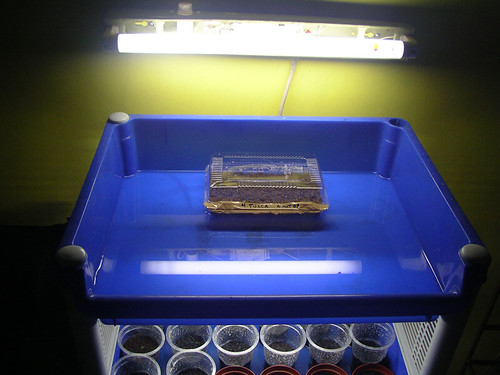
Fresh seed will start germinating within 4 weeks, but it may take as long as six months. When the seeds begin to sprout, keep providing them with moist medium, but be careful now, at they are very sensitive at this stage. Too much water and they will rot. Too little water and they will dry out and die. Only use very fine misting or water from the bottom. An experience will tell you whether it is time to water or not.
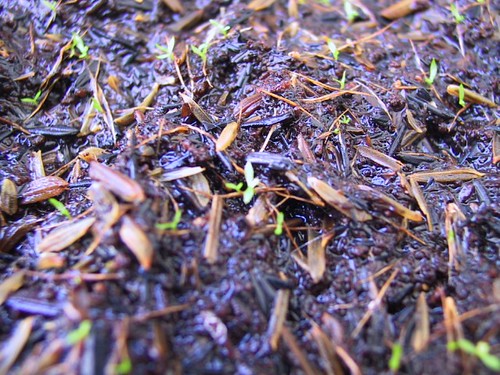
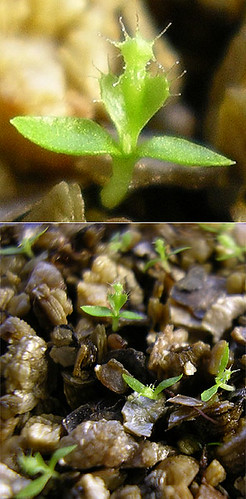
Most seedling Nepenthes are lost soon after germination. For the best survival rate, transplant seedlings on the week of germination. If transplanted with care and spaced about 1 to 2 cm apart in live sphagnum, pure vermiculite or cocopeat, fungus and desiccation problems are greatly reduced. I usually transplant my seedlings when they are still at cotyledon stage (~2mm leaf span) into mineral water plastic glasses and place the bottles on my dish rack. This time do not close the glass but try too keep the seedlings warm and humid but not stagnant and wet.
If you would like to read more on how to propagate Nepenthes from seeds, there a bunch of excellent resources on the Web. My favourite website is the Seed Germination Guide released by ICPS (International Carnivorous Plant Society). They have a special section on how to successfully grow highland Nepenthes from seed:
www.carnivorousplants.org/seedbank/seedgermguide.htm
On the whole, my Nepenthes propagation setup is shown as follows:
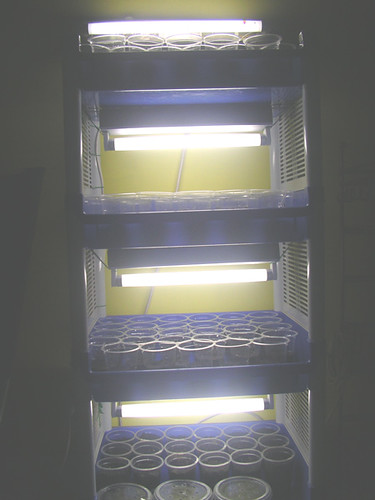
Written by Rajah
Mostly from my own experience
I also have a pdf version of this article but I don't know how to include it here.
Nepenthes Seed Propagation
by Rajah (herbatrop@yahoo.com)
Germinating Nepenthes seeds is not difficult, provided that you have time, space and fresh seeds.
Nepenthes seed is thread-like, thickening in the middle like a spindle. In order to get seed, both a male and female Nepenthes must be in flower at the same time. Due to the thin shape of the seeds, each female flower can produce an abundance of seed. Considering some plants can have hundreds of female flowers, a large female Nepenthes can produce a large amount of seed. These seeds are contained in female pods that will turn brown when ripe. Once harvested, the seeds should be planted as soon as possible because Nepenthes seed can not be stored for long periods of time, and do not take well to the freezer. Some Nepenthes seeds such as N. ampullaria, N. gracilis and N. bicalcarata lose viability faster than the other.
The first key to germinating Nepenthes seeds successfully is choosing the right environment. It includes humidity, temperature and light. Nepenthes seeds need high humidity, warm temperatures and sufficient light in order to be able to germinate. Depends on the species (lowland/highland), most species will germinate in temperatures between 25 to 30 C. If you live in a non-equatorial country, bottom heat may be necessary.
I live in an equatorial climate of intermediate altitude around 650 m asl and I realize that not all of you who read this article have the same climate, so what I am going to share with you here is my experience on germinating Nepenthes seeds indoor. But even indoor I have relatively high humidity of around 60% and a constant room temperature of around 28 C.
You need a good medium that will hold as much water for as long as possible. Commonly there are three types of medium used to germinate Nepenthes seeds, dead sphagnum moss, coconut dust (cocopeat) and pure vermiculite. I use three of them interchangeably but I will focus on dead sphagnum moss here as it seems to be the most widely available medium.
Before usage, it is important to grind up the moss by using food processor or chopper until the fiber becomes somewhat finer. The reason for this is twofold: first, nepenthes seeds are so thin and light and they have to “see” the light to be able to germinate. Long-fiber moss has too much gap and holes between them that can make Nepenthes seeds disappear. Secondly, it can be very difficult to pluck Nepenthes seedlings out of long fiber, as the fiber in the moss can interconnect and disturb the other seedlings. You attempt to remove one seedling, and the moss fibers ends up disturbing or breaking the roots of several others. Long fiber itself should not be used unless the seedlings will grow on in their germination spot for a year or more.
you may rehydrate the moss with boiling water to sterilize it somewhat. If you cook it too much, the moss breaks down and molds very easily when it is eventually contaminated.
Here is how the ground up sphagnum moss looks like:

Next, get some plastic box, punch some holes on the bottom and fill the box with the chopped moss. Sphagnum moss is expensive, and there is no need to fill the box too deeply. About 1-2 cm thickness is sufficient because the roots of new seedlings are not that long, unless you plan to use individual pots from the very beginning. Water the moss until saturated and sow the seeds very sparingly. Wetting the soil one final time before planting the seed aids in getting the seed to sit in contact with the soil, which helps with germination. Do not cover the seeds because they have to see the light. It is best to spray the sown seed with a fungicide to keep the seeds from molding.

I choose 10 W daylight fluorescent light mainly because it is relatively cheap. I have found that this type of lamp works well, as long as you hang it close enough above the seeds, around 15-20 cm apart will be ideal. I turn the light on for 24 hours a day, but I have heard that 18 W fluoresent lights on 16 hours a day will do just well.
After setting up your lighting system, you need to have a humid environment for your seed box. There are many ways to accomplish this, but I like the water tray method. I use a discarded dish racks and modify it into a compact germinating room. Fill the rack with just enough water to maintain high humidity around the moss, close the box with a transparent lid with plenty of holes and put it on the rack. Keep the moss humid and the light on.

Fresh seed will start germinating within 4 weeks, but it may take as long as six months. When the seeds begin to sprout, keep providing them with moist medium, but be careful now, at they are very sensitive at this stage. Too much water and they will rot. Too little water and they will dry out and die. Only use very fine misting or water from the bottom. An experience will tell you whether it is time to water or not.


Most seedling Nepenthes are lost soon after germination. For the best survival rate, transplant seedlings on the week of germination. If transplanted with care and spaced about 1 to 2 cm apart in live sphagnum, pure vermiculite or cocopeat, fungus and desiccation problems are greatly reduced. I usually transplant my seedlings when they are still at cotyledon stage (~2mm leaf span) into mineral water plastic glasses and place the bottles on my dish rack. This time do not close the glass but try too keep the seedlings warm and humid but not stagnant and wet.
If you would like to read more on how to propagate Nepenthes from seeds, there a bunch of excellent resources on the Web. My favourite website is the Seed Germination Guide released by ICPS (International Carnivorous Plant Society). They have a special section on how to successfully grow highland Nepenthes from seed:
www.carnivorousplants.org/seedbank/seedgermguide.htm
On the whole, my Nepenthes propagation setup is shown as follows:

Written by Rajah
Mostly from my own experience




 thanx for sharing rajah!
thanx for sharing rajah!

